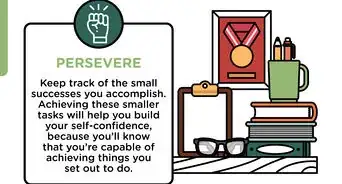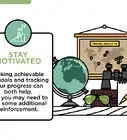This article was co-authored by Trudi Griffin, LPC, MS. Trudi Griffin is a Licensed Professional Counselor in Wisconsin specializing in Addictions and Mental Health. She provides therapy to people who struggle with addictions, mental health, and trauma in community health settings and private practice. She received her MS in Clinical Mental Health Counseling from Marquette University in 2011.
There are 9 references cited in this article, which can be found at the bottom of the page.
This article has been viewed 310,148 times.
When obstacles arrive, persistence can help you move over, around, or through them. The application of persistence to any task is often what sets apart successful people. Spending time each day working towards your goal, for example, increases your odds of success. It’s also important to ignore your detractors and keep going when you are faced with hardship or failure. Being persistent means putting one foot in front of the other, no matter what.
Things You Should Know
- Set specific, achievable goals. Having a goal to work toward will help keep you motivated.
- Break your goal down into smaller milestones so it feels less overwhelming.
- Reward yourself when you hit a milestone. Buy a shirt you've been wanting, go to your favorite restaurant, or treat yourself to a new video game.
Steps
Help with Setting Achievable Goals
Pursuing Your Goals with Persistence
-
1Set a goal. Spend some time thinking about exactly what results you wish to achieve and be as specific as you can. Establish a time frame for achieving each part of your final goal. Set your sights on a goal that is reasonable to accomplish.[1]
- As you set your goal, ask yourself not only what you want to accomplish, but why you want to accomplish it. Figuring out what drives your goal will help give you purpose in the beginning, and motivation as you move toward your target.
- If you want to lose weight, for example, your reasons may include wanting to feel more comfortable in your own skin, be more physically capable, and feel better about your appearance.
- It helps to write down your goal on a prominent place, such as your wall calendar.
-
2Break the goal down into smaller pieces. Divide the goal by a set of specific tasks that will take a certain amount of time to complete. A 1-hour goal could be broken up into 15-minute segments. Or, divide the task in segments, such as a particular number of files to sort each day.[2]
- Establishing many small goals within a single larger one will keep you motivated and on track.
Advertisement -
3Devote a set amount of time each day to your goal. You might even start by setting aside 5 minutes each day to work on your goal. Then, raise this up to 10 minutes each day by the second week and so on. If you have a swamped schedule, this will make working on your goal simply part of your routine and you are more likely to do it.[3]
-
4Place a goal reminder in a prominent place. If you are trying to save money to buy a house, stick a photo of your dream home to your fridge. If you are trying to pay off your credit card, attach a copy of the bill to your bathroom mirror. If you’d like an award at work, place a copy of last year’s award announcement on your desk.[4]
-
5Connect your goal to an already established habit. If you already brush your teeth before bed each night, simply add your goal of washing your face right afterwards. You can also water your plants at the same time that you go outside to take out the garbage or grab the mail. Or, drink more water at work by stopping at the cooler each time you leave your desk.[5]
-
6Keep your goals fun and exciting. Not every goal that you need to achieve, such as paying off a credit card, is going to be riveting. However, you can make it more interesting by turning it into a game with prizes or rewards at certain intervals. You can even make bets about how much you can achieve by when.[6]
- For example, turn on some music or listen to an audio book if you are working on a repetitive task.
-
7Stay true to your values while pursuing your goals. It’s very easy to get caught up in the moment and confuse persistence with permission to behave in a negative way. Instead, stay true to the idea of positive persistence. Treat others the way you’d like to be treated. Obey the rules while pursuing success.
- You’ll find that keeping a positive, pleasant attitude will also make others more willing to help you achieve your goals.
Persisting through Hardship and Failure
-
1Listen to but don't internalize your critics. Recognize that you will always have people around who will not support you or your goals. The key is to not let their words dominate you. Use them as motivation to prove your critics wrong, or tune them out if they feel too toxic.[7]
- For example, if a relative doesn’t support your professional ambitions, then you may need to stick to non-work topics when talking with them.
- This doesn’t hold totally true if someone is genuinely trying to offer you constructive advice or criticism. Other people sometimes see things you can't, and you can use their words for guidance. Use your best judgment to determine whether or not their words will be helpful or harmful to you.
-
2Build up a support network. Locate a support group in your area that focuses on the type of hardship that you are experiencing. Talk with trusted family members or friends about what you are experiencing and seek out their advice. Meet with a counselor to have a sounding board or someone who will just listen.[8]
- For example, you might join a social group for small business owners. You can feel comfortable discussing any hardships, such as rent raises, that you are coping with.
-
3Accept that failure happens. The most successful people in life have all failed. The difference between them and people who live in fear of failure is that successful people face the failure, learn from it, and use it to spur their next attempt. They persist because they know that failure is simply part of achievement.[9]
-
4Examine the underlying causes of your failure. If you are continually hitting roadblocks or problems when trying to reach a goal, take some time to think about why that might be. Weigh your actions and talents with a critical eye to see if they are truly good enough for what you are pursuing or if you might need to work a bit more or get some help.
- For example, if you keep stalling out at the interview stage for jobs, then you might need to polish your interview techniques.
- Think about whether you're self-sabotaging. Underlying beliefs or negative feelings can keep you from reaching your full potential. If you find yourself getting stuck and can't seem to move past it, check in with yourself to see if you're attitude is the root cause.
-
5Visualize your final achievement to stay motivated. When the going gets tough and you feel like just dropping everything, restore your sense of purpose by remembering your vision. Picture you completing your goal and how that will feel. Imagine the congratulations and reactions of those around you.[10]
-
6Be wary of escapism. If you feel defeated or downtrodden, you might turn toward the television or even food to escape reality for a few moments. Short, controlled moments of self-care or leisure can be a great way for you to reboot and regroup. However, if you find yourself spending all of your free time “escaping” then you are likely losing sight of your larger goals.
- Abusing alcohol and other substances is a particularly dangerous type of escapism. Look for more healthy ways to shift gears, such as working out.
- Don't beat yourself up for taking time to let your brain rest and recharge. Hanging out with friends, going for a walk, reading a good book, watching your favorite show, or even taking a nap can all be forms of self-care. Just don't focus on them so much that you stop chasing your goal.
-
7Reroute your energies if you determine that a goal is unattainable. This is not giving in or giving up, instead you are being persistent in utilizing your time and skills effectively. Look for a goal that is parallel to your original one or change directions entirely if that is what you need to do.
- For example, you might decide that pursuing a teaching degree is not for you, but you will need to find some sort of gainful employment goal.
Persisting with Requests or Refusals
-
1Maintain a consistent tone of voice. If you are making a request, then you’ll like need to adopt a conciliatory and friendly approach. Growing frustrated at the person’s refusals or hedges will only make success less likely. Similarly, if you are the person doing the refusing, keep a confident and clear tone of voice when making your refusal known.[11]
- For example, if you are repeatedly invited to an event that you don’t wish to attend, keep saying “no” in the same confident way until the person gets the message.
-
2Adopt the "broken record" technique. This is a common technique used in assertiveness training. You simply repeat the same continuous, clear statement about your feeling, intention, or decision. You stay calm and avoid becoming angry, defensive, or irritated mid-conversation.[12]
- For example, you might state, “I’m not comfortable with that.” You don't need to give any excuses or justifications for your refusal. Just keep saying your statement.
- This approach also requires that you avoid any attempts to sidetrack you and stay on your original message.
-
3See a workable compromise as a positive solution. When you ask for something or issue a refusal, it’s unlikely that the conversation will end there. Instead, you may need to work with someone else to find a solution that helps you both. When you reach a compromise, don’t view it as a failure. Instead, it’s another way to reach your original goal.[13]
- For example, you might ask a co-worker to send you a particular email, but they may not have it. However, they might give you the name of someone who could forward it to you.
Warnings
- Persistence is not a goal in and of itself. If you view it this way you risk becoming a stubborn person who refuses to see the larger picture or beyond yourself.⧼thumbs_response⧽
References
- ↑ https://www.psychologytoday.com/us/blog/notes-self/201308/how-set-goals
- ↑ https://www.inc.com/marissa-levin/10-habits-of-highly-persistent-people.html
- ↑ https://www.pickthebrain.com/blog/6-powerful-ways-become-persistent-never-quit/
- ↑ https://www.fastcompany.com/3044531/7-habits-of-highly-persistent-people
- ↑ https://www.fastcompany.com/3044531/7-habits-of-highly-persistent-people
- ↑ https://www.pickthebrain.com/blog/6-powerful-ways-become-persistent-never-quit/
- ↑ https://www.forbes.com/sites/ciocentral/2011/02/07/engineers-ignore-the-critics-follow-your-dreams-change-the-world/#3716100419a7
- ↑ https://www.mayoclinic.org/healthy-lifestyle/stress-management/in-depth/social-support/art-20044445
- ↑ https://www.pickthebrain.com/blog/6-powerful-ways-become-persistent-never-quit/
- ↑ https://www.realsimple.com/health/mind-mood/emotional-health/visualization-techniques#mental-visualization
- ↑ https://bothsidesofthetable.com/one-of-my-most-frequent-pieces-of-advice-be-politely-persistent-a5e198f369a6
- ↑ https://hbswk.hbs.edu/item/its-not-nagging-why-persistent-redundant-communication-works
- ↑ https://bothsidesofthetable.com/one-of-my-most-frequent-pieces-of-advice-be-politely-persistent-a5e198f369a6
- ↑ https://www.pickthebrain.com/blog/6-powerful-ways-become-persistent-never-quit/















































































